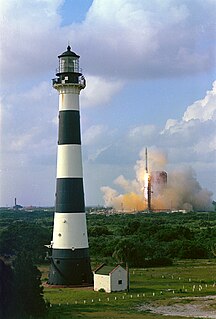Intelsat 2, formerly PAS-2, was a communications satellite operated by Intelsat which spent most of its operational life serving the Pacific Rim market from a longitude of 169° East. Launched in July 1994, the satellite was operated by PanAmSat until it merged with Intelsat in 2006. The spacecraft was renamed, along with the rest of PanAmSat's fleet, on 1 February 2007.

Intelsat 603 or IS-603, previously named Intelsat VI F-3, is a communications satellite operated by Intelsat. Launched in 1990, it was the second of five Intelsat VI satellites to be launched. The Intelsat VI series was constructed by Hughes Aircraft, based on the HS-389 satellite bus.
Orion 3 was an American spacecraft which was intended for use by Orion Network Systems, as a geostationary communications satellite. It was to have been positioned in geostationary orbit at a longitude of 139° East, from where it was to have provided communications services to Asia and Oceania. Due to a malfunction during launch, it was instead delivered to a useless low Earth orbit.
Intelsat 604, previously named Intelsat VI F-4, was a communications satellite operated by Intelsat. Launched in 1990, it was the third of five Intelsat VI satellites to be launched. The Intelsat VI series was constructed by Hughes Aircraft, based on the HS-389 satellite bus.

Intelsat II F-1, also known as Blue Bird was a communications satellite operated by Intelsat. Launched in 1966 it was intended for operations in geostationary orbit over the Pacific Ocean to provide a communications link between Australia and the United States, however a malfunction prevented the satellite from reaching its planned orbit.
Intelsat II F-2, also known as Lani Bird, was a communications satellite operated by Intelsat. Launched in 1967, it was operated in geostationary orbit at a longitude of 174 degrees east until 1969.
Intelsat II F-3, also known as Canary Bird was a communications satellite operated by Intelsat. Launched in 1967 it was operated in geostationary orbit, spending most of its operational life at a longitude of 15 degrees west.
Intelsat II F-4 was a communications satellite operated by Intelsat. Launched in 1967 it was operated in geostationary orbit at a longitude of 176 degrees east and later 166 degrees west.
Intelsat III F-1 was a communications satellite intended to be operated by Intelsat. Launched towards geostationary orbit in 1968 it failed to achieve orbit.
Intelsat III F-2 was a communications satellite operated by Intelsat. Launched in 1968 it was operated in geostationary orbit at a longitude of 24 degrees west for around eighteen months.
Intelsat III F-3 was a geostationary communications satellite operated by Intelsat. Launched in 1969 it was intended for operations over the Pacific Ocean; however, it spent most of its service life over the Indian Ocean at a longitude of 63 degrees east.
Intelsat III F-6 was a communications satellite owned by Intelsat. The satellite had an estimated useful life of 5 years.
Intelsat III F-8 was a communications satellite owned by Intelsat. The satellite had an estimated useful life of 5 years.

Intelsat IV F-5 was a geostationary communication satellite built by Hughes, it was owned by Intelsat. The satellite was based on the HS-312 platform and its estimated useful life was 7 years.
Intelsat IV F-7 was a geostationary communication satellite built by Hughes, it was owned by Intelsat. The satellite was based on the HS-312 platform and its estimated useful life was seven years.
Intelsat 802 was a communications satellite operated by Intelsat. Launched in 1997 it was operated in geostationary orbit at a longitude of 174 degrees west for around fourteen years.
NSS-5 is a communications satellite operated by Intelsat and after by SES World Skies. Launched in 1997 it was operated in geostationary orbit at a longitude of 50.5 degrees east for around 14 years.
Intelsat 804 was a communications satellite operated by Intelsat. Launched in 1997 it was operated in geostationary orbit at a longitude of 44 degrees east for around 8 years.
Intelsat 907 was a communications satellite operated by Intelsat.


